Case Study: Examining Walmart's Strategic Failures in Germany
VerifiedAdded on 2021/04/21
|5
|745
|133
Case Study
AI Summary
This case study examines Walmart's significant failure in the German market. It explores the impact of cultural and normative differences on business performance, highlighting how Walmart's practices clashed with German customs regarding trade unions, pricing, greetings, working hours, and brand perception. The analysis delves into the strategic missteps Walmart made, emphasizing the importance of market research, staffing, and communication tailored to the local context. It then discusses Walmart's competitive advantages, such as its everyday low price strategy and IT infrastructure, while questioning the sustainability of these advantages in a new market. The study concludes by identifying transferable advantages, such as the use of information technology, that Walmart could leverage in other global markets, particularly in supply chain management and online sales.
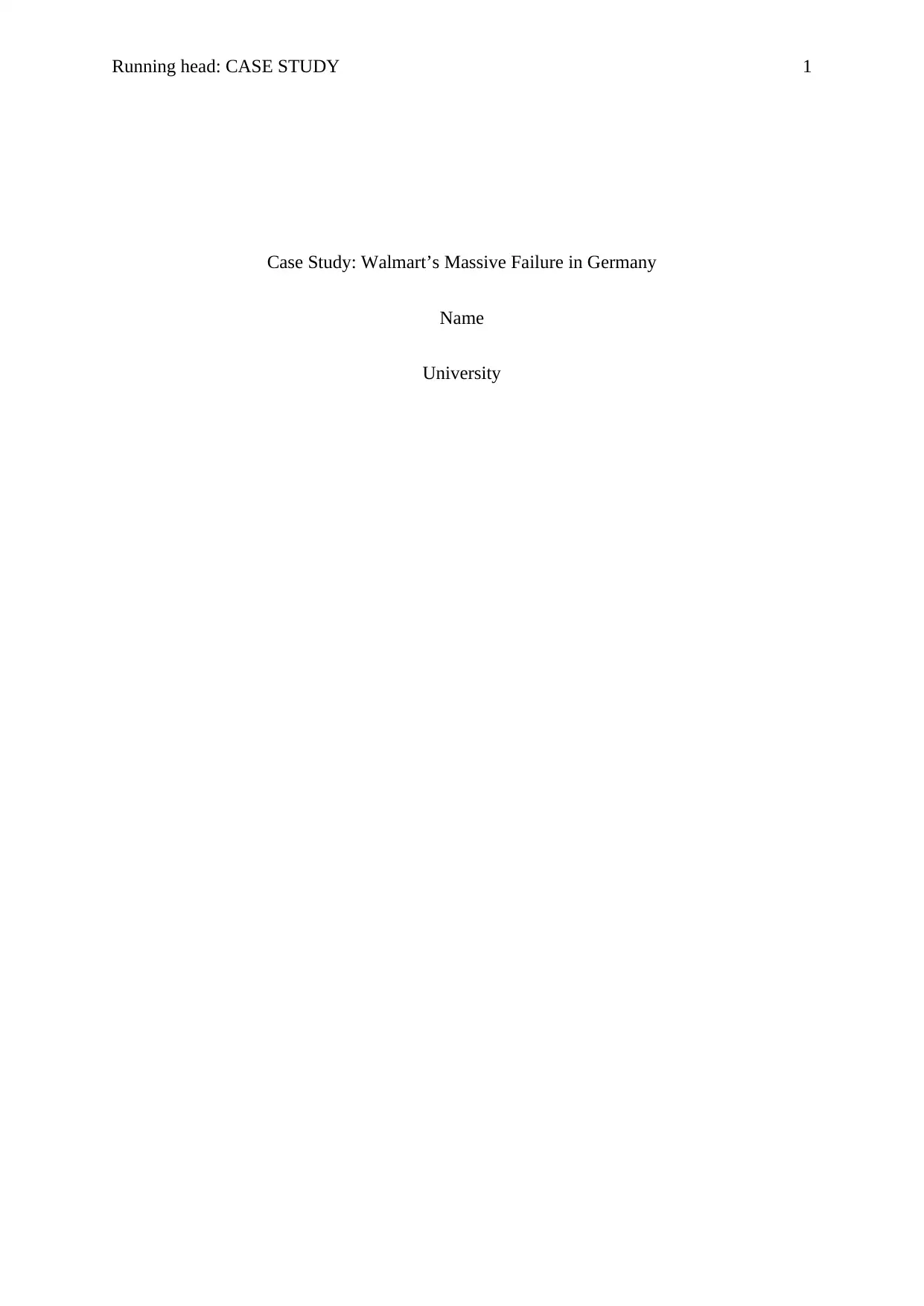
Running head: CASE STUDY 1
Case Study: Walmart’s Massive Failure in Germany
Name
University
Case Study: Walmart’s Massive Failure in Germany
Name
University
Paraphrase This Document
Need a fresh take? Get an instant paraphrase of this document with our AI Paraphraser
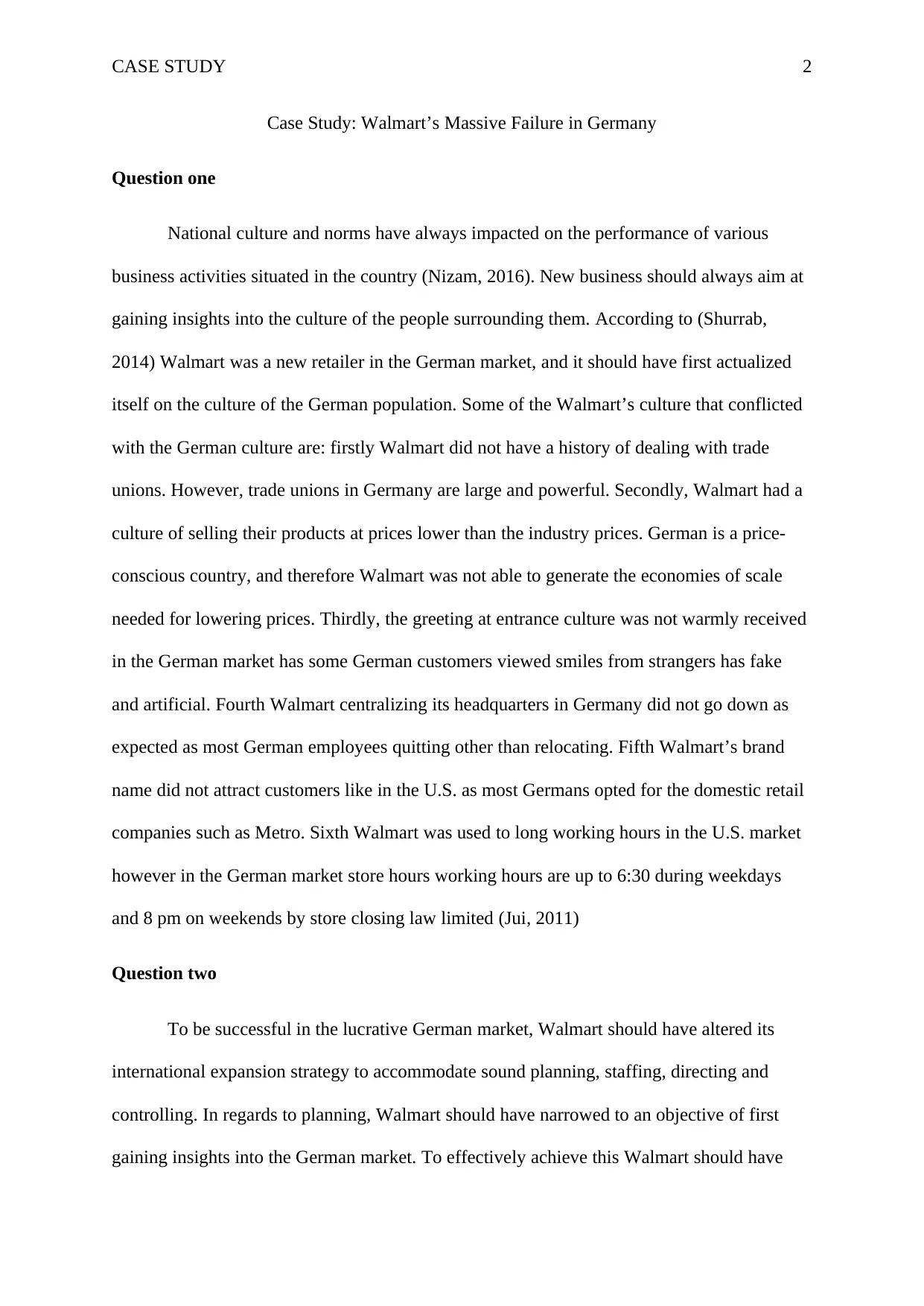
CASE STUDY 2
Case Study: Walmart’s Massive Failure in Germany
Question one
National culture and norms have always impacted on the performance of various
business activities situated in the country (Nizam, 2016). New business should always aim at
gaining insights into the culture of the people surrounding them. According to (Shurrab,
2014) Walmart was a new retailer in the German market, and it should have first actualized
itself on the culture of the German population. Some of the Walmart’s culture that conflicted
with the German culture are: firstly Walmart did not have a history of dealing with trade
unions. However, trade unions in Germany are large and powerful. Secondly, Walmart had a
culture of selling their products at prices lower than the industry prices. German is a price-
conscious country, and therefore Walmart was not able to generate the economies of scale
needed for lowering prices. Thirdly, the greeting at entrance culture was not warmly received
in the German market has some German customers viewed smiles from strangers has fake
and artificial. Fourth Walmart centralizing its headquarters in Germany did not go down as
expected as most German employees quitting other than relocating. Fifth Walmart’s brand
name did not attract customers like in the U.S. as most Germans opted for the domestic retail
companies such as Metro. Sixth Walmart was used to long working hours in the U.S. market
however in the German market store hours working hours are up to 6:30 during weekdays
and 8 pm on weekends by store closing law limited (Jui, 2011)
Question two
To be successful in the lucrative German market, Walmart should have altered its
international expansion strategy to accommodate sound planning, staffing, directing and
controlling. In regards to planning, Walmart should have narrowed to an objective of first
gaining insights into the German market. To effectively achieve this Walmart should have
Case Study: Walmart’s Massive Failure in Germany
Question one
National culture and norms have always impacted on the performance of various
business activities situated in the country (Nizam, 2016). New business should always aim at
gaining insights into the culture of the people surrounding them. According to (Shurrab,
2014) Walmart was a new retailer in the German market, and it should have first actualized
itself on the culture of the German population. Some of the Walmart’s culture that conflicted
with the German culture are: firstly Walmart did not have a history of dealing with trade
unions. However, trade unions in Germany are large and powerful. Secondly, Walmart had a
culture of selling their products at prices lower than the industry prices. German is a price-
conscious country, and therefore Walmart was not able to generate the economies of scale
needed for lowering prices. Thirdly, the greeting at entrance culture was not warmly received
in the German market has some German customers viewed smiles from strangers has fake
and artificial. Fourth Walmart centralizing its headquarters in Germany did not go down as
expected as most German employees quitting other than relocating. Fifth Walmart’s brand
name did not attract customers like in the U.S. as most Germans opted for the domestic retail
companies such as Metro. Sixth Walmart was used to long working hours in the U.S. market
however in the German market store hours working hours are up to 6:30 during weekdays
and 8 pm on weekends by store closing law limited (Jui, 2011)
Question two
To be successful in the lucrative German market, Walmart should have altered its
international expansion strategy to accommodate sound planning, staffing, directing and
controlling. In regards to planning, Walmart should have narrowed to an objective of first
gaining insights into the German market. To effectively achieve this Walmart should have
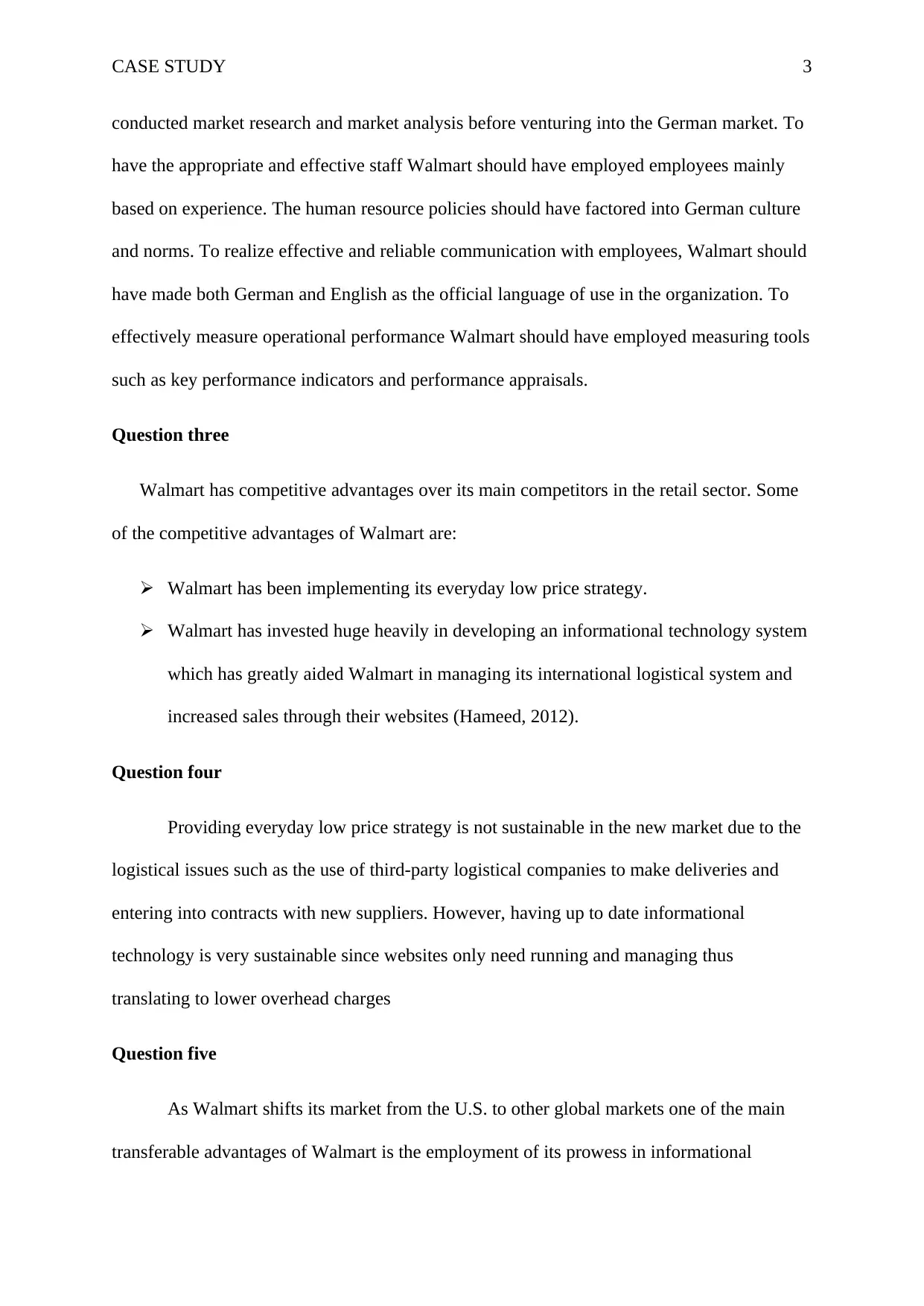
CASE STUDY 3
conducted market research and market analysis before venturing into the German market. To
have the appropriate and effective staff Walmart should have employed employees mainly
based on experience. The human resource policies should have factored into German culture
and norms. To realize effective and reliable communication with employees, Walmart should
have made both German and English as the official language of use in the organization. To
effectively measure operational performance Walmart should have employed measuring tools
such as key performance indicators and performance appraisals.
Question three
Walmart has competitive advantages over its main competitors in the retail sector. Some
of the competitive advantages of Walmart are:
Walmart has been implementing its everyday low price strategy.
Walmart has invested huge heavily in developing an informational technology system
which has greatly aided Walmart in managing its international logistical system and
increased sales through their websites (Hameed, 2012).
Question four
Providing everyday low price strategy is not sustainable in the new market due to the
logistical issues such as the use of third-party logistical companies to make deliveries and
entering into contracts with new suppliers. However, having up to date informational
technology is very sustainable since websites only need running and managing thus
translating to lower overhead charges
Question five
As Walmart shifts its market from the U.S. to other global markets one of the main
transferable advantages of Walmart is the employment of its prowess in informational
conducted market research and market analysis before venturing into the German market. To
have the appropriate and effective staff Walmart should have employed employees mainly
based on experience. The human resource policies should have factored into German culture
and norms. To realize effective and reliable communication with employees, Walmart should
have made both German and English as the official language of use in the organization. To
effectively measure operational performance Walmart should have employed measuring tools
such as key performance indicators and performance appraisals.
Question three
Walmart has competitive advantages over its main competitors in the retail sector. Some
of the competitive advantages of Walmart are:
Walmart has been implementing its everyday low price strategy.
Walmart has invested huge heavily in developing an informational technology system
which has greatly aided Walmart in managing its international logistical system and
increased sales through their websites (Hameed, 2012).
Question four
Providing everyday low price strategy is not sustainable in the new market due to the
logistical issues such as the use of third-party logistical companies to make deliveries and
entering into contracts with new suppliers. However, having up to date informational
technology is very sustainable since websites only need running and managing thus
translating to lower overhead charges
Question five
As Walmart shifts its market from the U.S. to other global markets one of the main
transferable advantages of Walmart is the employment of its prowess in informational
⊘ This is a preview!⊘
Do you want full access?
Subscribe today to unlock all pages.

Trusted by 1+ million students worldwide
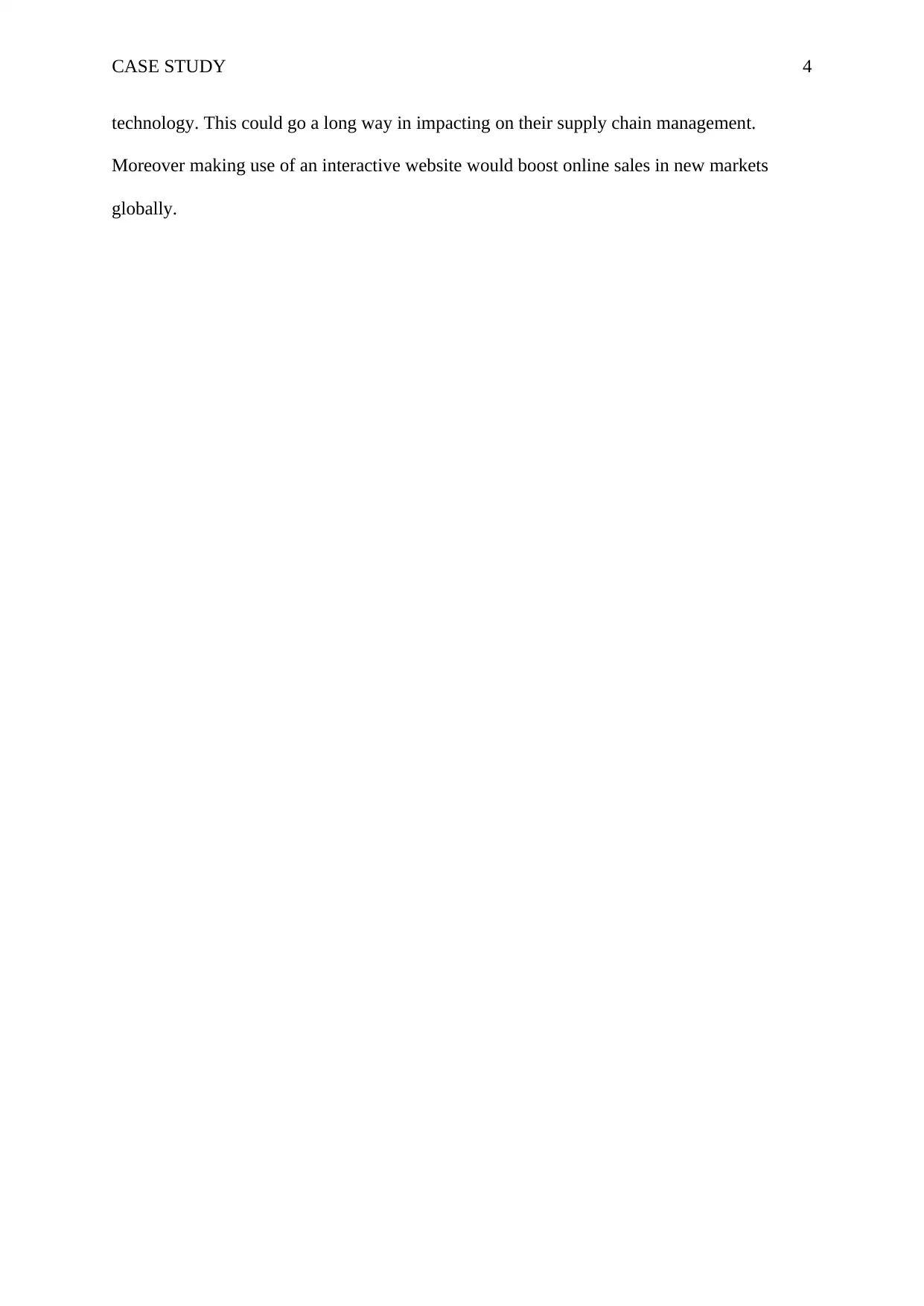
CASE STUDY 4
technology. This could go a long way in impacting on their supply chain management.
Moreover making use of an interactive website would boost online sales in new markets
globally.
technology. This could go a long way in impacting on their supply chain management.
Moreover making use of an interactive website would boost online sales in new markets
globally.
Paraphrase This Document
Need a fresh take? Get an instant paraphrase of this document with our AI Paraphraser
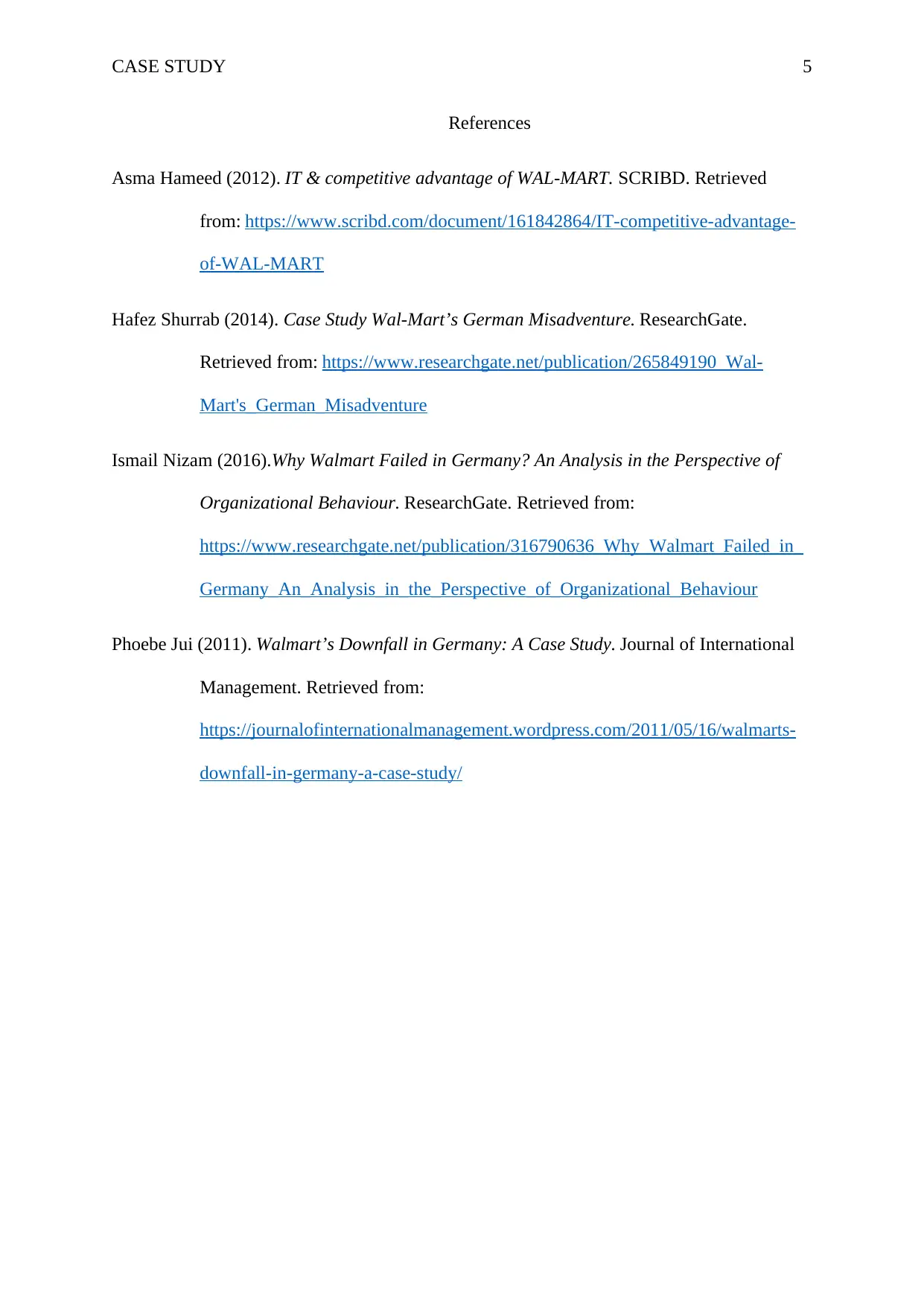
CASE STUDY 5
References
Asma Hameed (2012). IT & competitive advantage of WAL-MART. SCRIBD. Retrieved
from: https://www.scribd.com/document/161842864/IT-competitive-advantage-
of-WAL-MART
Hafez Shurrab (2014). Case Study Wal-Mart’s German Misadventure. ResearchGate.
Retrieved from: https://www.researchgate.net/publication/265849190_Wal-
Mart's_German_Misadventure
Ismail Nizam (2016).Why Walmart Failed in Germany? An Analysis in the Perspective of
Organizational Behaviour. ResearchGate. Retrieved from:
https://www.researchgate.net/publication/316790636_Why_Walmart_Failed_in_
Germany_An_Analysis_in_the_Perspective_of_Organizational_Behaviour
Phoebe Jui (2011). Walmart’s Downfall in Germany: A Case Study. Journal of International
Management. Retrieved from:
https://journalofinternationalmanagement.wordpress.com/2011/05/16/walmarts-
downfall-in-germany-a-case-study/
References
Asma Hameed (2012). IT & competitive advantage of WAL-MART. SCRIBD. Retrieved
from: https://www.scribd.com/document/161842864/IT-competitive-advantage-
of-WAL-MART
Hafez Shurrab (2014). Case Study Wal-Mart’s German Misadventure. ResearchGate.
Retrieved from: https://www.researchgate.net/publication/265849190_Wal-
Mart's_German_Misadventure
Ismail Nizam (2016).Why Walmart Failed in Germany? An Analysis in the Perspective of
Organizational Behaviour. ResearchGate. Retrieved from:
https://www.researchgate.net/publication/316790636_Why_Walmart_Failed_in_
Germany_An_Analysis_in_the_Perspective_of_Organizational_Behaviour
Phoebe Jui (2011). Walmart’s Downfall in Germany: A Case Study. Journal of International
Management. Retrieved from:
https://journalofinternationalmanagement.wordpress.com/2011/05/16/walmarts-
downfall-in-germany-a-case-study/
1 out of 5
Related Documents
Your All-in-One AI-Powered Toolkit for Academic Success.
+13062052269
info@desklib.com
Available 24*7 on WhatsApp / Email
![[object Object]](/_next/static/media/star-bottom.7253800d.svg)
Unlock your academic potential
Copyright © 2020–2025 A2Z Services. All Rights Reserved. Developed and managed by ZUCOL.





